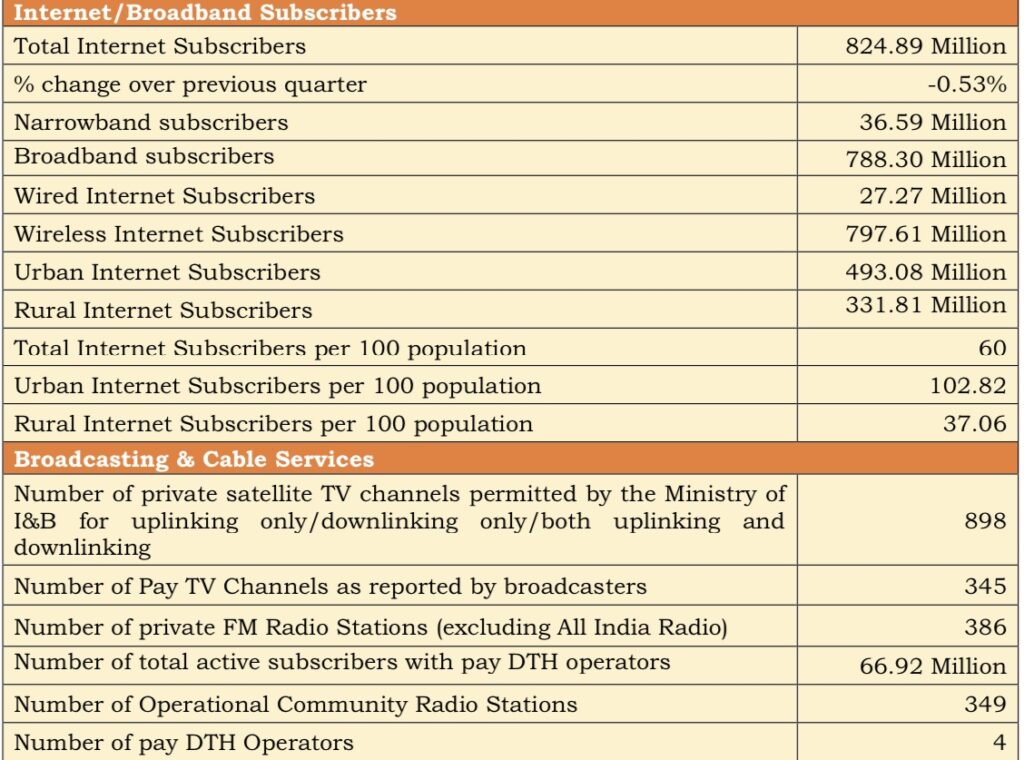A total of approximately 898 private satellite TV channels were permitted by the Ministry of Information and Broadcasting (MIB) to operate in and from India as of March 2022, sector regulator TRAI said Tuesday.
Out of the 885 permitted satellite TV channels, which are available for downlinking in India, 345 are pay TV channels, TRAI said in its ‘The Indian Telecom Services Performance Indicators’ report for the period of January-March 2022.
The data showed that out of the 345 pay TV channels, 248 are broadcast in SD or standard definition format, while 97 were HD TV channels.
Since the introduction of DTH in the year 2003, the Indian DTH (direct- to-home) services have displayed phenomenal growth, TRAI said, adding during the QE March 31, 2022, there were four pay DTH service providers in the country.

Pay DTH has attained a total active subscriber base of around 66.92 million as of March 2022. This is in addition to the subscribers of the DD FreeDish (Doordarshan free DTH service).
On the radio front, apart from the services operated by pubcaster All India Radio, there were 386 operational private FM Radio channels in 113 cities operated by 36 private FM radio operators as of March 2022.
The advertisement revenue reported by FM radio operators during the quarter ending March 2022 in respect of 386 private FM Radio channels stood at Rs 362.63 crore as against Rs 421.74 crore in respect of 386 private FM Radio channels for the previous quarter, December 2021.
India also had 349 operational community radio stations as of March 2022.
The number of telephone subscribers in India decreased from 1,178.41 million at the end of Dec-21 to 1,166.93 million at the end of Mar-22, registering a decline rate of 0.97 percent over the previous quarter.

This reflected a year-n-year (YOY) decline rate of 2.85 percent over the same quarter of the last year. The overall tele-density in India decreased from 85.91 percent as in QE Dec-21 to 84.88 percent as in QE Mar-22.
Telephone subscribers in urban areas decreased from 655.20 million at the end of Dec-21 to 647.11 million at the end of Mar-22 and urban tele- density also decreased to 134.94 percent during the same period.
Rural telephone subscribers decreased from 523.21 million at the end of Dec-21 to 519.82 million at the end of Mar-22 and rural tele-density also decreased from 58.50 percent to 58.07 percent during the same period.
Out of the total subscription, the share of rural subscription increased from 44.40 percent at the end of Dec-21 to 44.55 percent at the end of Mar-22.
 SRK, Aamir, Big B, Ted Sarandos, WPP CEO, MPA chief, other stars, to headline WAVES
SRK, Aamir, Big B, Ted Sarandos, WPP CEO, MPA chief, other stars, to headline WAVES  TIPS Music ends FY25 on high note with 29% revenue growth
TIPS Music ends FY25 on high note with 29% revenue growth  WAVES’ Bharat Pavillion to showcase Indian media’s evolution,culture
WAVES’ Bharat Pavillion to showcase Indian media’s evolution,culture  Telecom subs base up marginally; Trai withholds updated b’band data
Telecom subs base up marginally; Trai withholds updated b’band data  Sony AATH to launch ‘Jiyo Gopuda’ on April 26
Sony AATH to launch ‘Jiyo Gopuda’ on April 26  Rajkummar Rao’s ‘Maalik’ gets new theatrical release date
Rajkummar Rao’s ‘Maalik’ gets new theatrical release date  Kriti Sanon joins Dreame as brand’s first-ever ambassador in India
Kriti Sanon joins Dreame as brand’s first-ever ambassador in India  YO YO Honey Singh, Stage Aaj Tak wrap up ‘Millionaire Tour’
YO YO Honey Singh, Stage Aaj Tak wrap up ‘Millionaire Tour’  Prime Video announces global premiere for ‘Crazxy’
Prime Video announces global premiere for ‘Crazxy’ 








